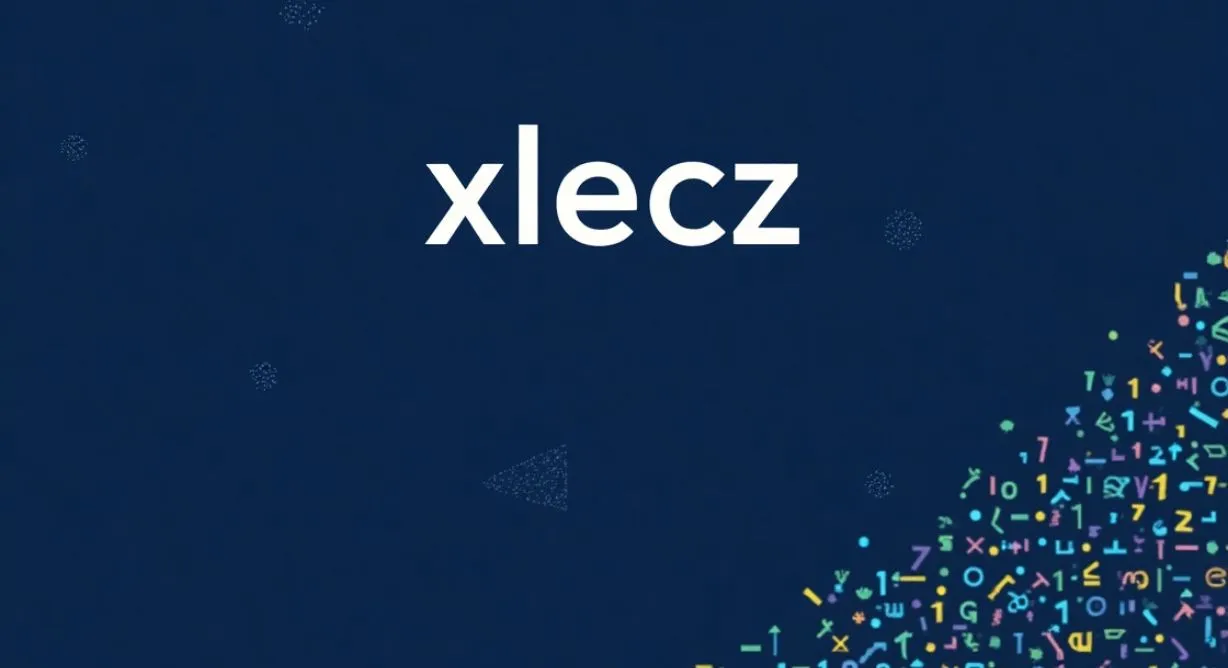In today’s fast-paced, data-driven world, businesses are increasingly relying on technology to enhance their decision-making processes and streamline operations. With the sheer volume of data generated daily, organizations are constantly seeking ways to extract meaningful insights from it. Enter XLECZ – an innovative platform designed to integrate, analyze, and act upon data in real-time, providing organizations with the ability to make more informed decisions, increase efficiency, and gain a competitive edge. As industries evolve, it is revolutionizing how businesses leverage data, providing them with advanced tools to drive growth and innovation.
But what is XLECZ, and why is it gaining so much attention across industries? This article explores what makes it so impactful, its core components, applications in various sectors, and how it empowers businesses to capitalize on their data. Whether you’re a tech enthusiast or a business leader looking for solutions to stay ahead of the competition, understanding XLECZ could be the key to unlocking new levels of operational efficiency and business success.
What is XLECZ?
XLECZ is more than just a cutting-edge technology; it represents a new paradigm in how organizations approach data and analytics. At its core, XLECZ combines the power of data integration, artificial intelligence (AI), cloud computing, and advanced analytics into a unified platform. This integrated approach breaks down traditional data silos, allowing businesses to bring together data from multiple sources and act on it in real-time.
In today’s digital age, where data is referred to as the “new oil,” organizations are constantly searching for ways to maximize its value. XLECZ helps businesses achieve this by offering a seamless solution that turns raw, disparate data into actionable insights. It allows companies to understand customer behaviors, optimize operations, reduce costs, and predict future trends, thereby enabling data-driven decision-making that drives growth.
Key Components of XLECZ
Understanding how XLECZ works begins with exploring its core components. Each of these elements plays a crucial role in ensuring that data is not only integrated but also analyzed and acted upon effectively.
Data Integration
Data integration is the foundational step in the XLECZ process, ensuring that data from various sources—such as databases, APIs, and cloud storage—can be brought together into one cohesive system. In today’s interconnected world, businesses generate data across a wide range of platforms, and this data is often fragmented and stored in different formats.
XLECZ simplifies the process by creating a unified dataset that provides businesses with a complete view of their operations. This comprehensive integration means that companies no longer need to deal with data silos, where information is isolated in different departments or systems. Instead, they can access a single, consolidated data source that offers valuable insights across multiple facets of their business, from customer behaviors to operational trends.
Data Analytics
Once the data is integrated, the next crucial step is data analytics. XLECZ utilizes sophisticated machine learning algorithms and statistical techniques to analyze large amounts of data in a fraction of the time it would take humans to process it manually. This process allows businesses to uncover patterns, trends, and anomalies that may otherwise go unnoticed.
The power of it lies in its ability to dive deep into complex datasets and extract meaningful insights. For instance, a retail business can use it to analyze customer purchasing behavior, while a manufacturing company might identify inefficiencies in its production lines. By recognizing these patterns, organizations can make proactive decisions, adjust strategies, and stay ahead of market changes.
Artificial Intelligence
Artificial Intelligence (AI) is a game-changer when it comes to enhancing the capabilities of XLECZ. AI empowers businesses to automate processes, predict future trends, and uncover insights based on historical data. Machine learning models continuously improve over time, ensuring that decisions made using XLECZ are based on the most up-to-date and accurate information available.
For example, AI-powered predictive analytics can help businesses forecast customer demand, plan inventory more efficiently, and identify potential bottlenecks in supply chains. By using AI to analyze data and provide actionable recommendations, it enables businesses to reduce human error, increase accuracy, and improve operational performance. Moreover, AI’s ability to adapt to new data over time makes XLECZ a dynamic, ever-evolving tool that continuously improves as the business grows.
Visualization and Reporting
Data analysis can often be overwhelming, especially when it involves complex datasets. That’s where visualization and reporting come into play. It takes complex data findings and presents them in easy-to-understand formats like charts, graphs, and interactive dashboards. These visual representations allow decision-makers to quickly grasp key insights and act on them without getting lost in raw numbers.
Real-time dashboards provide businesses with up-to-the-minute information on critical metrics, allowing stakeholders to monitor performance across different departments and make faster decisions. Whether it’s tracking sales, customer engagement, or operational efficiency, XLECZ’s visualization tools ensure that important insights are front and center, enabling faster, more informed decisions that drive business success.
XLECZ in Action: Applications Across Industries
It is a versatile platform that offers significant advantages to businesses across a wide range of industries. Below are some of the most impactful applications of XLECZ, demonstrating how this technology is transforming various sectors:
Healthcare
In healthcare, data is crucial for improving patient outcomes and optimizing operations. XLECZ can be used to analyze patient data, providing healthcare providers with insights into potential risks, treatment effectiveness, and patient behavior. By combining historical data and predictive analytics, healthcare organizations can forecast patient needs, identify at-risk individuals, and streamline care processes.
For example, predictive analytics could help hospitals predict which patients are most likely to require urgent care, allowing for proactive interventions. It can also be used to track hospital performance, identify inefficiencies, and optimize resource allocation, ensuring that medical staff are better equipped to handle patient care.
Retail
Retailers constantly seek ways to better understand customer preferences and optimize inventory management. XLECZ helps retailers achieve this by providing in-depth insights into consumer behavior, purchasing patterns, and market trends. By analyzing customer data, retailers can tailor marketing efforts, optimize stock levels, and improve customer experiences.
For example, a fashion retailer might use it to identify which products are most popular with certain customer demographics. This allows them to adjust their inventory and create targeted marketing campaigns that resonate with their audience. Moreover, by understanding purchasing behaviors, retailers can offer personalized product recommendations, boosting customer satisfaction and loyalty.
Finance
The financial services industry relies heavily on data to make informed decisions. XLECZ provides financial institutions with the ability to analyze market trends, assess risks, and make accurate predictions based on historical data. Banks, investment firms, and insurance companies can use XLECZ to manage portfolios, identify new investment opportunities, and mitigate risks.
For example, XLECZ can analyze financial markets to predict trends, helping traders make informed decisions. It can also help banks detect fraudulent activities by identifying unusual patterns in transactions. By using predictive analytics, financial institutions can better anticipate market fluctuations and react to changes swiftly, ensuring they remain competitive in an ever-changing landscape.
Manufacturing
In manufacturing, operational efficiency is key to profitability. XLECZ helps manufacturers optimize their processes by offering predictive maintenance and real-time performance monitoring. By analyzing data from equipment and machinery, XLECZ can predict when maintenance is required, reducing the risk of downtime and costly repairs.
Manufacturers can also use XLECZ to identify inefficiencies in their production processes, optimize supply chains, and improve quality control. For instance, if production data reveals a bottleneck in the assembly line, manufacturers can adjust workflows or implement automation to speed up processes. This helps improve overall productivity and reduces operational costs.
The Benefits of XLECZ: Why It’s Worth the Investment
Organizations that implement XLECZ can expect to experience a variety of benefits that drive business success. Here are some of the most significant advantages of using this advanced data analytics platform:
Enhanced Decision-Making
With real-time data at their fingertips, businesses can make decisions faster and with greater confidence. XLECZ enables decision-makers to access up-to-date insights, ensuring that their decisions are based on the most current and accurate information. This is particularly important in industries where rapid decision-making can make the difference between success and failure.
Cost Efficiency
One of the most compelling reasons to adopt XLECZ is its ability to reduce costs. By automating processes, predicting maintenance needs, and optimizing operations, businesses can eliminate inefficiencies and cut unnecessary expenses. For example, predictive analytics can help organizations avoid costly downtime in manufacturing or identify opportunities for inventory reduction in retail.
Increased Agility
In today’s fast-moving business environment, agility is essential. XLECZ empowers organizations to quickly adapt to changing market conditions by providing real-time insights that inform strategy adjustments. Whether it’s adjusting marketing campaigns, shifting product offerings, or modifying operational processes, XLECZ enables businesses to pivot swiftly and effectively.
Improved Customer Experience
By leveraging XLECZ’s powerful analytics and AI capabilities, businesses can create personalized experiences for their customers. Understanding customer preferences and behaviors allows organizations to tailor their offerings, resulting in increased customer satisfaction, loyalty, and ultimately, sales. Whether it’s recommending products or offering personalized services, XLECZ helps businesses foster stronger relationships with their customers.
Overcoming the Challenges of Implementing XLECZ
While XLECZ offers numerous advantages, businesses must be prepared to address certain challenges when implementing the platform. These include:
Data Privacy and Security
As with any technology that relies on vast amounts of data, data privacy and security are paramount. Organizations must ensure that sensitive information is protected and that they comply with relevant regulations such as GDPR. Implementing robust data governance frameworks is critical to safeguarding privacy and maintaining trust with customers.
Integration Complexities
Integrating data from various sources can be a complex and resource-intensive process. Businesses must carefully plan their XLECZ implementation to ensure smooth integration across systems. This may involve working with IT professionals to ensure that data from legacy systems and modern platforms can be harmonized effectively.
Skills Gap
Operating XLECZ requires specialized skills in data analytics, AI, and cloud computing. Many organizations may face a skills gap when trying to deploy the platform. To overcome this challenge, businesses will need to invest in training their existing workforce or hire new talent with the necessary expertise.
The Future of XLECZ: What Lies Ahead?
As technology continues to evolve, so will XLECZ. The future promises even more advanced AI models, enhanced cloud solutions, and the integration of natural language processing (NLP) capabilities. These innovations will further empower businesses to make more informed decisions, optimize their operations, and stay ahead of the competition.
By embracing the future of XLECZ, organizations will be well-positioned to take full advantage of emerging technologies and remain agile in a rapidly changing world. The opportunities for innovation are limitless, and XLECZ will play a crucial role in shaping the future of industries worldwide.
Conclusion
XLECZ is at the forefront of data-driven innovation, offering businesses a powerful platform to integrate, analyze, and act upon data in real-time. With its advanced capabilities in data integration, artificial intelligence, predictive analytics, and visualization, XLECZ is transforming industries ranging from healthcare to retail, finance, and manufacturing. By embracing this cutting-edge technology, businesses can unlock new levels of efficiency, agility, and customer satisfaction. The future of XLECZ looks bright, and its potential to revolutionize how businesses operate cannot be overstated. By adopting XLECZ, organizations will be better equipped to navigate the complexities of the digital landscape and achieve long-term success.

